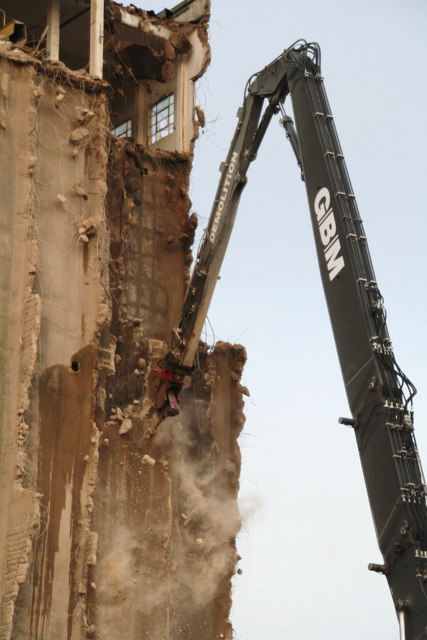Goodbye to the ABM Maltings: stage 3
Introduction
The photograph on this page of Goodbye to the ABM Maltings: stage 3 by Chris as part of the Geograph project.
The Geograph project started in 2005 with the aim of publishing, organising and preserving representative images for every square kilometre of Great Britain, Ireland and the Isle of Man.
There are currently over 7.5m images from over 14,400 individuals and you can help contribute to the project by visiting https://www.geograph.org.uk

Image: © Chris Taken: 14 Jan 2015
Louth's skyline is changing. The monster building has finally met its match and is being munched into history by the giant machine (see also Image] and Image]). A slightly smaller version, named in a competition by a schoolchild as the "Wreckasaurus", has had to take a back seat as "Maxi-Me" chomps its way through the highest part of the building. For stages 1 and 2 of the demolition see Image and Image The Malt Kiln has been a slightly less charismatic landmark than St. James' Church on the Louth horizon. It is well past its sell-by date, and Aldi are planning to do everyone a favour by building a supermarket in its place. It has put up the good fight, and a demolition squad who moved in in about 2003 withdrew, seemingly with their tails between their legs, for the building remained intact, complete with its treasure trove of asbestos and its thick reinforced concrete walls. However it is not without its own fascinating and very impressive history. Construction began in 1949 and replaced the old maltings, which were built around 1870 and destroyed by German bombs in 1940. The new site had to be where its predecessor stood to qualify for war compensation. It took two years to finish the project, with post-war cement rationing slowing down the process. The production section was finished for malting to begin in 1952. The interior was an extraordinary honeycomb of 96 eight foot square, 90ft high storage chambers for barley and malt. Dalgety's took over ABM in 1972 then Paul's Malt in 1987. Their plans to expand production by building three huge new silos were refused in 1989 by East Lindsey District Council and on appeal, following bitter opposition from the Civic Trust and conservation minded councillors. Louth was producing 30,000 tonnes a year. In the late 1990s Paul's invested £30,000,000 in a new plant at Bury St Edmunds which increased production by 100,000 tonnes. Read more, and photos: http://www.midlandsheritage.co.uk/industrial/4541-abm-paul-maltings-louth.html#ixzz3GVZyJ87w Residents of housing developments in close proximity will be relieved that, finally, they will no longer be looking out at a vast and overbearing concrete wall. The sign says that the road will be closed from January to February, while they demolish the high part. See also Image, Image], Image] and Image For aerial shot of the Maltings and station before this demolition work see Image For aerial shots during demolition see Image] and Image
Image Location






